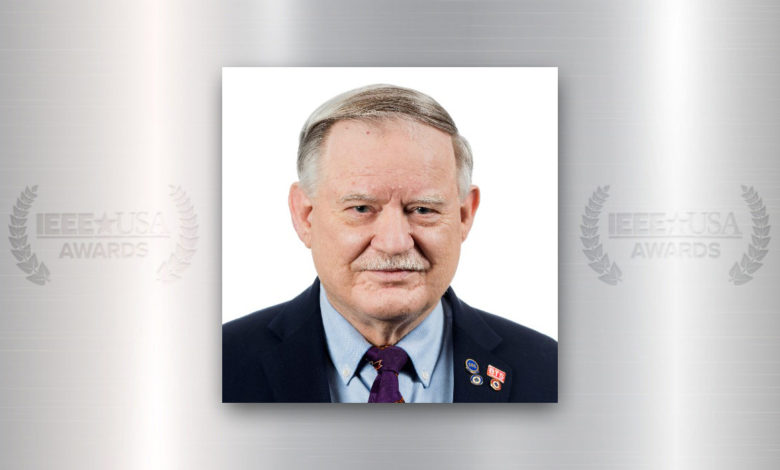
While in military service, Dwight D. Eisenhower defined leadership as “the art of getting someone else to do something you want done because he wants to do it.”
But colleagues of IEEE Life Senior Member Ralph Hogan use softer, better-natured terms to describe his leadership skills. According to Russell Kinner, also an IEEE Life Senior Member and one of his endorsers for the 2019 IEEE-USA Award for Distinguished Literary Contributions Furthering Public Understanding and the Advancement of the Engineering Profession, “quiet persuasion” characterizes one of Hogan’s most distinctive traits.
“Ralph isn’t out there making a big to-do about things,” explains Kinner, who has known and worked with Hogan for more than 15 years in the IEEE Phoenix Section, including on the Executive Committee. “He knows how to get people’s attention, so they’ll then think about what he’s advocating.”
By Hogan’s own admission, “I’m not a Type A personality, but I pay attention.” He adds, “When something needs to be done, I don’t mind picking up the balls.”
Now, this IEEE Senior Life Member, who has picked up more than his share of balls in his many years of IEEE and professional leadership, is being recognized for his role in developing a distinctive, mutually rewarding partnership between members of the Phoenix Section and KJZZ, the National Public Radio member station for the region.
In 2017, Hogan spearheaded, and then championed, a collaboration in which members provided technology-related story ideas to reporters on the station’s Science and Innovation Desk. The IEEE Foundation supported and sponsored the effort with a $50,000 grant, and KJZZ aired 53 news and feature stories, all stemming from the partnership. All the stories helped inform and educate the public about how local researchers, companies and institutions make important contributions to society.
“More than anything else,” notes Hogan, “we wanted to create greater awareness about the achievements of local engineers and technologists. They are carrying out a great deal of technological work in Phoenix, and the surrounding valley — but much of the public isn’t aware of it.
“Another, secondary goal was to encourage individuals with engineering backgrounds to either maintain their membership, or to join IEEE,” he adds.
According to IEEE Senior Member Vasudeva Prasad Atluri, who nominated Hogan for the award, the IEEE Phoenix Section had been seeking a way for its members to provide balanced information about technology and its applications that would reach the general public. At one of its meetings, the Section’s Executive Committee asked Hogan to inquire about the possibility at the station.
Calling on his skill for “quiet persuasion,” Hogan got the attention of station management, and he persuaded them to consider the collaboration. After they approved it, the station’s grants manager worked with the IEEE Foundation to secure funds for implementing the program. The grant included establishing a Technology Information Exchange, which permitted Section members to meet quarterly with the station’s reporters and editors to discuss story ideas. Members could also submit their suggestions through a Google Drive document the Phoenix Section publicized in their newsletter. This method for ideas and suggestions did not exist before the IEEE Foundation provided funding.
The result was a stream of 53 technology-oriented news and feature articles — each several minutes long, and with an IEEE sponsorship message — that aired throughout 2017. Just a few of the stories included: Navajo students in Shiprock learning to code; 3-D security at Sky Harbor Airport in Phoenix; a new driver warning system to detect elk on the roadway; and the possible use of geometry to create the ancient Sun Temple at Mesa Verde National Park in Colorado.
With an average weekly cumulative average of 265,300 radio listeners, plus another 54,000 who stream KJZZ, the stories enjoyed a significant audience throughout the station’s broad listening area, which extends well beyond Phoenix into southwest New Mexico.
Atluri notes that according to a 2017 Edison Research study, radio listeners’ interest in science, innovation and technology stories is tied with education as the second most popular topic news radio stations cover. Only stories on politics/public policy rate more highly.
The broadcast medium — which Hogan describes as “one-to-many” — has been the heart of his professional career. He is currently serving the second year of a two-year term as president of the IEEE Broadcast Technology Society; is a past president and a Fellow of the Society of Broadcast Engineers; and in 2006, Hogan was the founding president of the Association of Public Radio Engineers. He is active on many committees and working groups within these societies; the topics range from advanced television standards to national certification for broadcast engineers.
For his contributions as chair of IEEE Region 6 Membership Development from 2013-2018, IEEE and IEEE-USA have recognized Hogan. Under his leadership, and applying a “micro volunteering” strategy that then-Region 6 Director, Thomas Coughlin suggested, members personally called and emailed others about renewing their membership. Ten sections across the Region set new retention records.
A New Orleans native and an IEEE member since his undergraduate years at the University of New Orleans, Hogan was working in the school’s then-multimedia department, when it launched WWNO — one of the first national public radio (NPR) stations in the city. Working with the staff engineers, he got his feet wet in the business. After graduation and for some years, Hogan held several progressively responsible broadcasting jobs in Louisiana. An NPR senior management opportunity in Boise, Idaho, took him more than 2,000 miles to the Northwest city.
Since 2008, Hogan has been Associate General Manager for Engineering Technology for the Rio Salado College Division of Public Service. The umbrella organization within Maricopa Community Colleges oversees KJZZ, KABQ, Arizona’s radio reading service, and KJZZ’s youth media center.
Whether he’s focused on the “one to many” broadcast field, his passion for membership development, or creating greater public awareness about engineering achievements, IEEE members are undoubtedly grateful for Ralph Hogan’s skill of “quiet persuasion.”
Seeking Nominations for 2020 IEEE-USA AwardsIEEE-USA is now accepting nominations for 2020 awards — recognizing excellence, outstanding service and contributions in furtherance of its objectives. The deadline to nominate is 15 September. For a full list of awards and for more information on how to nominate, visit: https://ieeeusa.org/volunteers/awards-recognition/ See also: 2019 IEEE-USA Awards Honor Eight Members for Excellence, Service, Contributions |
Helen Horwitz is an award-winning freelance writer who lives in Albuquerque, N.M. She was with IEEE from 1991 through 2011, the first nine as Staff Director, IEEE Corporate Communications.






